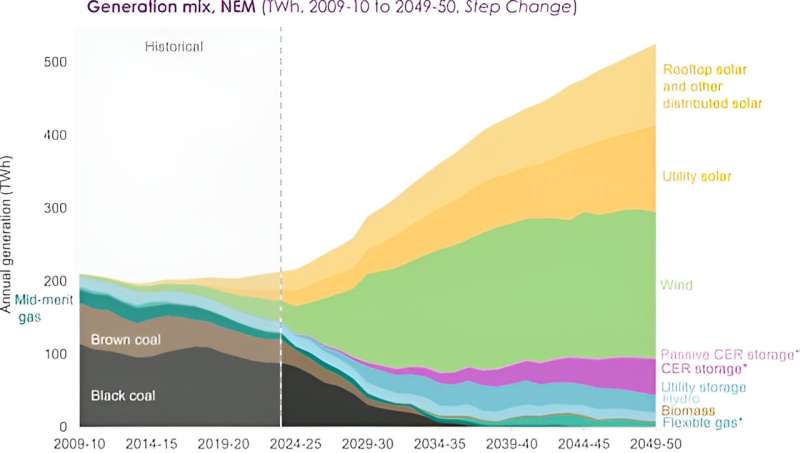
Coal will no longer be burned for power in Australia within 14 years. To replace it will require faster deployment of solar and wind, storage, new transmission lines and some firming gas capacity.
That's a very brief summary of a large and influential document—the Integrated System Plan issued by the Australian Energy Market Operator (AEMO) every two years.
The latest version of this plan was issued today. Think of it as a roadmap, showing what we need to build and where to be able to wean ourselves off burning fossil fuels for electricity.
It shows the lowest cost way to give us electricity in the future is renewable energy, connected with transmission and distribution, firmed with storage and using gas-powered generation as farmers might use a diesel generator—as a backup plan.
What about nuclear, given Peter Dutton's pledge to build seven reactors? The plan doesn't consider it, because nuclear power is currently not legal. But an accompanying AEMO fact sheet notes CSIRO's GenCost report found nuclear generation to be a lot more expensive than other options:
"In fact, it is one of the most expensive ways to generate electricity according to GenCost [and] the time it would take to design and build nuclear generation would be too slow to replace retiring coal fired generation."
What is this plan for?
Australia's main grid connects eastern and southern states, where most of us live. Historically, it was built to connect cheap but polluting coal plants to large cities.
As coal plants retire, we need a different grid so we can draw renewable power from many different locations and use storage as backup.
That's what this plan is intended to do. To create it, AEMO relies on detailed modeling and consultation across the energy sector. This brings it to what the operator calls an "optimal development path"—energy speak for the cheapest and most effective mix of electricity generation, storage and transmission, which meets our reliability and security needs while supporting emission cutting policies in the long-term interests of consumers.
One of the most important roles for the plan is to show where we need new electrical infrastructure—especially transmission lines.
The key findings of the final plan have not materially changed from the draft. But there are some changes worth noting.
Emissions reductions to the fore
In November last year, emissions reductions were formally embedded as an objective in our national electricity laws.
In March this year, the market commission issued guidelines on how to apply these changes to the objectives in various processes, including the Integrated System Plan.
There are important figures in this guidance, namely the value of emissions reduction, set at A$70 per ton today to $420 per ton by 2050. This is not a direct carbon price. It lets us assess the value of different grid pathways in terms of cutting emissions.
AEMO calculated an extra $3.3 billion in benefits realized in the optimal development path when including this value. Including this benefit is expected to help get some transmission projects get approval.
This article is republished from The Conversation under a Creative Commons license. Read the original article.![]()
Citation: Coal-free in 14 years as renewables rush in: New blueprint shows how to green the grid—without nuclear (2024, June 26) retrieved 26 June 2024 from https://techxplore.com/news/2024-06-coal-free-years-renewables-blueprint.html
This document is subject to copyright. Apart from any fair dealing for the purpose of private study or research, no part may be reproduced without the written permission. The content is provided for information purposes only.
